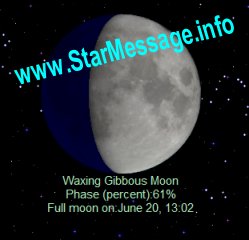Waxing Cresent, Moon phase of Thursday, August 8th, 2024
Primary tabs
Follow the moon phases with our StarMessage screensaver.

If you like the moon, you should get its screensaver.
A waxing crescent moon-sometimes called a "young moon" is always seen in the west after sunset. At this moon phase, the Earth, moon and sun are located nearly on a line in space. If they were more precisely on a line, as they are at new moon, we wouldn't see the moon. The moon would travel across the sky during the day, lost in the sun's glare. Instead, a waxing crescent moon is seen one day to several days after new moon. It rises one hour to several hours behind the sun and follows the sun across the sky during the day. When the sun sets, and the sky darkens, the moon pops into view in the western sky.
Because the waxing crescent moon is nearly on a line with the Earth and sun, the "day side" is facing mostly away from us. We see only a slender fraction of the day side: a crescent moon. Each evening, because the moon is moving eastward in orbit around Earth, the moon appears farther from the sunset glare. Each evening, as the moon's orbital motion carries it away from the Earth/sun line, we see more of the moon's day side. Thus the crescent in the west after sunset appears to wax, or grow fatter each evening.
Note that a crescent moon has nothing to do with Earth's shadow on the moon. The only time Earth's shadow can fall on the moon is at full moon, during a lunar eclipse. There IS a shadow on a crescent moon, but it's the moon's OWN shadow. Night on the moon happens on the part of the moon submerged in the moon's own shadow. Likewise, night on Earth happens on the part of Earth submerged in Earth's own shadow.
You sometimes see a pale glow on the darkened portion (night side) of a crescent moon. This glow is due to light reflected from Earth's day side. It's called "earthshine."
Read more at EarthSky.org

